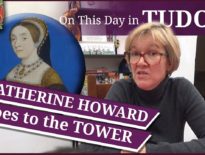Warning - Contains a description of a burning at the stake.
On this day in history, 9th February 1555, Protestant John Hooper, Bishop of Gloucester and Worcester, and former Cistercian monk, was burned at the stake for heresy in Gloucester.
It was an awful execution due to green faggots being used, and John Foxe writes of there being three attempts over a period of 45 minutes. Awful, just awful.
Also on this day in history, 9th February 1542, Jane Boleyn, Lady Rochford, was taken to the Tower of London to prepare for her execution. Find out more in last year’s video:
Also on this day in history:
- 1554 – Original date set for the execution of Lady Jane Grey and Lord Guildford Dudley. Extra time was given for Dr John Feckenham, Mary I's Chaplain and Confessor, to try and save Jane's soul by persuading her to recant her Protestant faith and return to the Catholic fold.
- 1555 – Burning of Rowland Taylor, Protestant martyr, Rector of Hadleigh in Suffolk, Canon of Rochester Cathedral, Archdeacon of Bury St Edmunds, Archdeacon of Cornwall and former chaplain to Thomas Cranmer. He was burned for heresy on Aldham Common, near Hadleigh.
- 1604 – Death of Anne Dudley (née Russell), former maid-of-honour to Elizabeth I, Countess of Warwick and third wife of Ambrose Dudley, Earl of Warwick. She died at North Hall in Northaw, Hertfordshire, the property left to her by her husband on his death in 1590. Anne served Elizabeth I as an extraordinary Gentlewoman of the Privy Chamber until Elizabeth's death. Anne chose to be buried with her family, the Russells, at Chenies in Buckinghamshire, rather than with her husband at Warwick.
Transcript:
On this day in history, 9th February 1555, Protestant John Hooper, Bishop of Gloucester and Worcester, and former Cistercian monk, was burned at the stake for heresy in Gloucester.
Hooper had left the monastic life after reading the works of Reformers Zwingli and Bullinger, and he had lived in Switzerland for a time in Henry VIII’s reign, before returning in Edward VI’s reign and working as chaplain to the king’s uncle, Edward Seymour, Duke of Somerset and Lord Protector. He was consecrated as Bishop of Gloucester in 1551, and then succeeded Nicholas Heath as Bishop of Worcester in 1552.
Following the accession of the Catholic Queen Mary I, Hooper was deprived of his bishopric in March 1554 due to his marriage, and martyrologist John Foxe writes of how he was imprisoned in the Fleet after being falsely accused of owing Queen Mary I money. He was then taken to the Counter in Southwark to be examined. After he refused to recant his faith, Hooper was moved to Newgate Prison, and then, after further attempts to make him recant, he was taken to Gloucester to prepare for his execution. Foxe states that his former friend, Sir Anthony Kingston was appointed by the queen “to attend at his execution”. Foxe writes “As soon as he saw the bishop he burst into tears. With tender entreaties he exhorted him to live. ‘True it is,’ said the bishop, ‘that death is bitter, and life is sweet; but alas! consider that the death to come is more bitter, and the life to come is more sweet.’”
Foxe then gives an account of Bishop Hooper's execution, a burning which took a long time to kill the poor man:
“About eight o'clock, on February 9, 1555, he was led forth, and many thousand persons were collected, as it was market-day. All the way, being straitly charged not to speak, and beholding the people, who mourned bitterly for him, he would sometimes lift up his eyes towards heaven, and look very cheerfully upon such as he knew: and he was never known, during the time of his being among them, to look with so cheerful and ruddy a countenance as he did at that time. When he came to the place appointed where he should die, he smilingly beheld the stake and preparation made for him, which was near unto the great elm tree over against the college of priests, where he used to preach.
Now, after he had entered into prayer, a box was brought and laid before him upon a stool, with his pardon from the queen, if he would turn. At the sight whereof he cried, “If you love my soul, away with it!” The box being taken away, Lord Chandois said, “Seeing there is no remedy; despatch him quickly.”
Command was now given that the fire should be kindled. But because there were not more green fagots than two horses could carry, it kindled not speedily, and was a pretty while also before it took the reeds upon the fagots. At length it burned about him, but the wind having full strength at that place, and being a lowering cold morning, it blew the flame from him, so that he was in a manner little more than touched by the fire.
Within a space after, a few dry fagots were brought, and a new fire kindled with fagots, (for there were no more reeds) and those burned at the nether parts, but had small power above, because of the wind, saving that it burnt his hair and scorched his skin a little. In the time of which fire, even as at the first flame, he prayed, saying mildly, and not very loud, but as one without pain, "O Jesus, Son of David, have mercy upon me, and receive my soul!" After the second fire was spent, he wiped both his eyes with his hands, and beholding the people, he said with an indifferent, loud voice, "For God's love, good people, let me have more fire!" and all this while his nether parts did burn; but the fagots were so few that the flame only singed his upper parts.
The third fire was kindled within a while after, which was more extreme than the other two. In this fire he prayed with a loud voice, "Lord Jesus, have mercy upon me! Lord Jesus receive my spirit!" And these were the last words he was heard to utter. But when he was black in the mouth, and his tongue so swollen that he could not speak, yet his lips went until they were shrunk to the gums: and he knocked his breast with his hands until one of his arms fell off, and then knocked still with the other, while the fat, water, and blood dropped out at his fingers' ends, until by renewing the fire, his strength was gone, and his hand clave fast in knocking to the iron upon his breast. Then immediately bowing forwards, he yielded up his spirit.
Thus was he three quarters of an hour or more in the fire.
Even as a lamb, patiently he abode the extremity thereof, neither moving forwards, backwards, nor to any side; but he died as quietly as a child in his bed. And he now reigneth, I doubt not, as a blessed martyr in the joys of heaven, prepared for the faithful in Christ before the foundations of the world; for whose constancy all Christians are bound to praise God.”
In Queen Victoria’s reign, in 1862, a monument to Bishop Hooper was erected in St Mary’s Square, Gloucester, where Hooper was burned, just outside his former cathedral. It features a statue of Hooper wearing his bishop’s robes and mitre, holding a book under his left arm and with his right hand extended in the act of blessing his congregation. A plaque reads “Gloria soli Deo / For the witness of Jesvs and for the Word of God / not accepting deliverance/ John Hooper DD Bishop of Gloucester / and Worcester was burnt to ashes on this spot February 9 / Anno Domini 1555”.




He was an ancestor of mine, I knew it was a gruesome death but I didn’t know about the length of the fire.